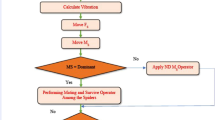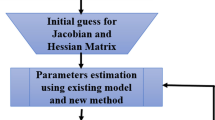Abstract
This study uses novel evolutionary algorithms and computational techniques to analyze wind potential on flat, complex coastal, and offshore sites utilizing mast as well as remote sensing data. The wind data were recorded using remote sensing technique and conventional technique. The optimum Weibull parameters are estimated using nine methods. The genetic algorithm, particle swarm optimization, and TLBO algorithms are compared and evaluated. The goodness of fit test, such as root mean square error test (RMSE), mean absolute percentage error (MAPE), coefficient of determination (R2), and chi-square test (X2), is used to evaluate the accuracy of the selected methods. Parameter estimates are used to compute wind densities. The TLBO and PSO algorithms outperformed genetic algorithms in terms of efficiency. This research compares remote sensing measurements to cup anemometer measurements.














Similar content being viewed by others
Data availability
The datasets used and/or analyzed during the current study are available from the corresponding author on reasonable request.
References
Adaramola MS, Agelin-Chaab M, Paul SS (2014) Assessment of wind power generation along the coast of Ghana. Energy Convers Manage 77:61–69
Akdag SA, Dinler A (2009) A new method to estimate Weibull parameters for wind energy applications. Energy Convers Manag 50(7):1761–1766. https://doi.org/10.1016/j.enconman.2009.03.020
Akdag SA, Bagiorgas HS, Mihalakakou G (2010) Use of two-component Weibull mixtures in the analysis of wind speed in the Eastern Mediterranean. Appl Energy 87(8):2566–2573. https://doi.org/10.1016/j.apenergy.2010.02.033
Akgul FG, Senoglu B, Arslan T (2016) An alternative distribution to Weibull for modeling the wind speed data: inverse Weibull distribution. Energy Convers Manag 114:234–240. https://doi.org/10.1016/j.enconman.2016.02.026
Akpinar EK, Akpinar S (2006) An assessment of wind turbine characteristics and wind energy characteristics for electricity production. Energy Sources, Part A 28(10):941–953
Arslan T, Bulut YM, Yavuz AA (2014) Comparative study of numerical methods for determining Weibull parameters for wind energy potential. Renew Sust Energ Rev 40:820–825. https://doi.org/10.1016/j.rser.2014.08.009
Ashtine M, Bello R, Higuchi K (2016) Assessment of wind energy potential over Ontario and Great Lakes using the NARR data: 1980–2012. Renew Sustain Energy Rev 1(56):272–282
Ayodele TR, Ogunjuyigbe AS, Amusan TO (2016) Wind power utilization assessment and economic analysis of wind turbines across fifteen locations in the six geographical zones of Nigeria. J Clean Prod 15(129):341–349
Bahrami A, Teimourian A, Okoye CO, Shiri H (2019) Technical and economic analysis of wind energy potential in Uzbekistan. J Clean Prod 20(223):801–814
Boopathi K, Kushwaha R, Balaraman K, Bastin J, Kanagavel P, Prasad DR (2021) Assessment of wind power potential in the coastal region of Tamil Nadu, India. Ocean Eng 1(219):108356
Boudia SM, Guerri O (2015) Investigation of wind power potential at Oran, northwest of Algeria. Energy Convers Manage 15(105):81–92
Carneiro TC, Melo SP, Carvalho PC, Braga AP (2016) Particle swarm optimization method for estimation of Weibull parameters: a case study for the Brazilian northeast region. Renew Energy 1(86):751–759
Carvalho D, Rocha A, Gómez-Gesteira M, Santos CS (2017) Offshore winds and wind energy production estimates derived from ASCAT, OSCAT, numerical weather prediction models and buoys–a comparative study for the Iberian Peninsula Atlantic coast. Renew Energy 1(102):433–444
Cavazzi S, Dutton AG (2016) An Offshore Wind Energy Geographic Information System (OWE-GIS) for assessment of the UK’s offshore wind energy potential. Renewable Energy 1(87):212–228
Chaurasiya PK, Ahmed S, Warudkar V (2018) Comparative analysis of Weibull parameters for wind data measured from met-mast and remote sensing techniques. Renew Energy 1(115):1153–1165
Chaurasiya PK, Abul Kalam A, Vilas W, Siraj A (2021) Chapter 5 - Advancement in remote sensing of wind energy. Adv Clean Energy Technologies:207–233
Dong Y, Wang J, Jiang H, Shi X (2013) Intelligent optimized wind resource assessment and wind turbines selection in Huitengxile of Inner Mongolia. China Appl Energy 1(109):239–253
George F (2014) A comparison of shape and scale estimators of the two-parameter Weibull distribution. J Mod Appl Stat Methods 13(1):23–35. https://doi.org/10.22237/jmasm/1398916920
Global wind energy council reports (2015) http://www.gwec.net/global-figures/wind-energy-global-status/. Accessed 03–12–2016
Hong L, Moller B (2011) Offshore wind energy potential in China: under technical, spatial and economic constraints. Energy 36(7):4482–4491
Jowder FA (2009) Wind power analysis and site matching of wind turbine generators in Kingdom of Bahrain. Appl Energy 86(4):538–545. https://doi.org/10.1016/j.apenergy.2008.08.006
Justus CG, Hargraves WR, Mikhail A, Graber D (1997) Methods for estimating wind speed frequency distributions. J Appl Meteorol 350–353.
Khahro F, Tabbassum K, Soomro AM, Dong L, Liao X (2014) Evaluation of wind power production prospective and Weibull parameter estimation methods for Babaurband, Sindh Pakistan. Energy Convers Manag 78:956–967. https://doi.org/10.1016/j.enconman.2013.06.062
Kongnam C, Nuchprayoon S (2010) A particle swarm optimization for wind energy control problem. Renew Energy 35(11):2431–2438
Kumar MB, Balasubramaniyan S, Padmanaban S, Holm-Nielsen JB (2019) Wind energy potential assessment by weibull parameter estimation using multiverse optimization method: a case study of Tirumala region in India. Energies 12(11):2158. https://doi.org/10.3390/en12112158
Li Y, Wu XP, Li QS, Tee KF (2018) Assessment of onshore wind energy potential under different geographical climate conditions in China. Energy 1(152):498–511
Liu FJ, Chen PH, Kuo SS, Su DC, Chang TP, Yu YH, Lin TC (2011) Wind characterization analysis incorporating genetic algorithm: a case study in Taiwan Strait. Energy 36(5):2611–2619
Masseran N (2015) Evaluating wind power density models and their statistical properties. Energy 84:533–41. https://doi.org/10.1016/j.energy.2015.03.018
Mohammadi K, Alavi O, Mostafaeipour A, Goudarzi N, Jalilvand M (2016) Assessing different parameters estimation methods of Weibull distribution to compute wind power density. Energy Convers Manag 108:322–335. https://doi.org/10.1016/j.enconman.2015.11.015
Mohandes MA, Rehman S (2014) Short term wind speed estimation in Saudi Arabia. J Wind Eng Ind Aerodyn 1(128):37–53
Mukulo BM, Ngaruiya JM, Kamau JN (2014) Determination of wind energy potential in the Mwingi-Kitui plateau of Kenya. Renew Energy 1(63):18–22
NIWE (2019) India’s Wind Potential Atlas at 120m agl. NIWE Website:77. https://niwe.res.in/assets/Docu/Indias_Wind_Potential_Atlas_at_120m_agl.pdf. Accessed 20–04–2022
Ohunakin OS, Adaramola MS, Oyewola OM (2011) Wind energy evaluation for electricity generation using WECS in seven selected locations in Nigeria. Appl Energy 88(9):3197–3206
Patidar H, Shende V, Baredar P et al (2022a) Comparative study of offshore wind energy potential assessment using different Weibull parameters estimation methods. Environ Sci Pollut Res 29:46341–46356. https://doi.org/10.1007/s11356-022-19109-x
Patidar H, Shende V, Baredar P et al (2022b) Comparative evaluation of optimal Weibull parameters for wind power predictions using numerical and metaheuristic optimization methods for different Indian terrains. Environ Sci Pollut Res. https://doi.org/10.1007/s11356-022-24395-6
Patidar H, Shende V, Baredar P et al (2022c) Comparative analysis of wind potential and characteristics using metaheuristic optimization algorithms at different places in India. Int J Environ Sci Technol. https://doi.org/10.1007/s13762-022-04678-8
Petrović A, Đurišić Ž (2021) Genetic algorithm based optimized model for the selection of wind turbine for any site-specific wind conditions. Energy 1(236):121476
Pishgar-Komleh SH, Keyhani A, Sefeedpari P (2015) Wind speed and power density analysis based on Weibull and Rayleigh distributions (a case study: Firouzkooh county of Iran). Renew Sust Energ Rev 42:313–322. https://doi.org/10.1016/j.rser.2014.10.028
Ramírez FJ, Honrubia-Escribano A, Gómez-Lázaro E, Pham DT (2018) The role of wind energy production in addressing the European renewable energy targets: the case of Spain. J Clean Prod 20(196):1198–1212
Rocha PAC, Sousa RC, Andrade CF, Silva MEV (2012) Comparison of seven numerical methods for determining Weibull parameters for wind energy generation in the northeast region of Brazil. Appl Energy 89(1):395–400. https://doi.org/10.1016/j.apenergy.2011.08.003
Saleh H, Abou El-Azm Aly A, Abdel-Hady S (2012) Assessment of different methods used to estimate Weibull distribution parameters for wind speed in Zafarana wind farm, Suez Gulf. Egypt. Energy 44(1):710–719. https://doi.org/10.1016/j.energy.2012.05.021
Sharma PK, Warudkar V, Ahmed S (2019) Application of lidar and measure correlate predict method in offshore wind resource assessments. J Clean Prod 1(215):534–543
Shu ZR, Li QS, Chan PW (2015) Statistical analysis of wind characteristics and wind energy potential in Hong Kong. Energy Convers Manag 1(101):644–657
Verma M, Ghritlahre HK, Chaurasiya PK, Ahmed S, Bajpai S (2021) Optimization of wind power plant sizing and placement by the application of multi-objective genetic algorithm (GA) in Madhya Pradesh India. Sustain Comput: Inform Syst. https://doi.org/10.1016/j.suscom.2021.100606
Acknowledgements
The researchers are thankful to the assistance offered by the faculties of NIT Bhopal for providing the support to facilitate this study.
Author information
Authors and Affiliations
Contributions
V. Shende: conceptualization, data curation, methodology, writing—original draft, review and editing, software. H. Patidar: visualization, software, validation, resources. P. Baredar: review, supervision. M. Agrawal: review, supervision.
Corresponding author
Ethics declarations
Ethics approval and consent to participate
Not applicable.
Consent for publication
Not applicable.
Competing interests
The authors declare no competing interests.
Additional information
Responsible Editor: Marcus Schulz
Publisher's note
Springer Nature remains neutral with regard to jurisdictional claims in published maps and institutional affiliations.
We have not submitted my manuscript to a preprint server before submitting it to “Environmental Science and Pollution Research.”.
Rights and permissions
Springer Nature or its licensor (e.g. a society or other partner) holds exclusive rights to this article under a publishing agreement with the author(s) or other rightsholder(s); author self-archiving of the accepted manuscript version of this article is solely governed by the terms of such publishing agreement and applicable law.
About this article
Cite this article
Shende, V., Patidar, H., Baredar, P. et al. Estimation of wind characteristics at different topographical conditions using doppler remote sensing instrument—a comparative study using optimization algorithm. Environ Sci Pollut Res 30, 48587–48603 (2023). https://doi.org/10.1007/s11356-023-25689-z
Received:
Accepted:
Published:
Issue Date:
DOI: https://doi.org/10.1007/s11356-023-25689-z




